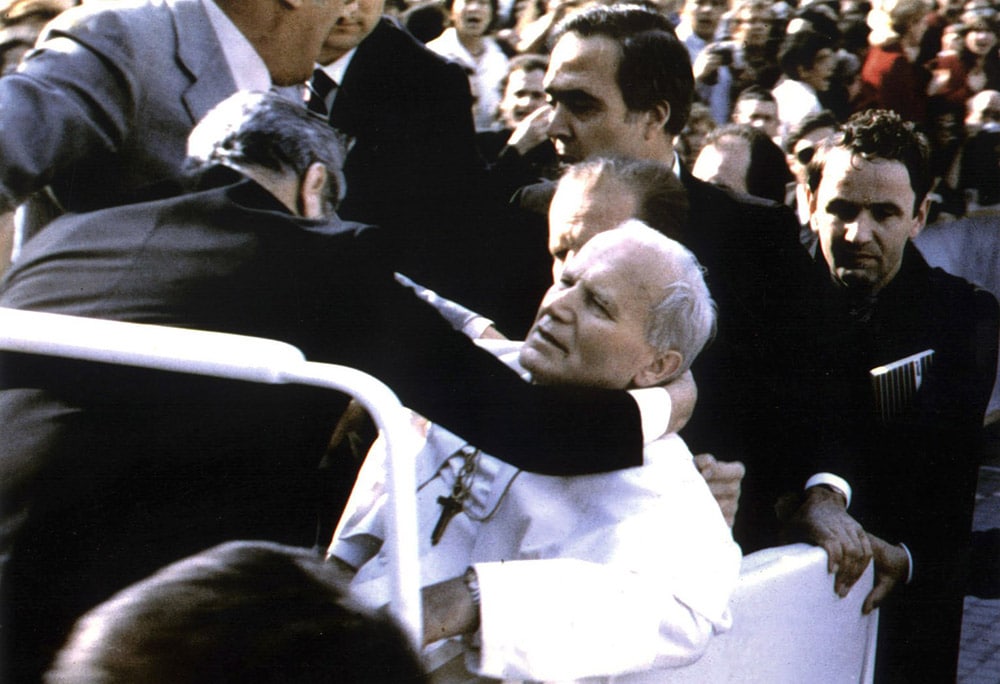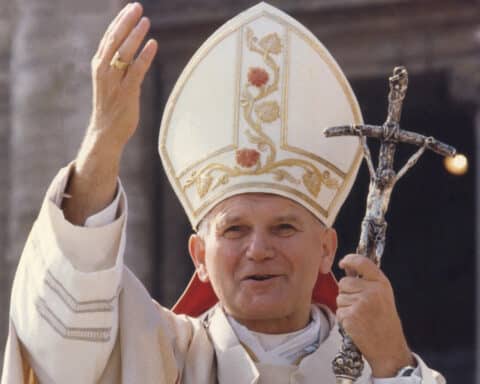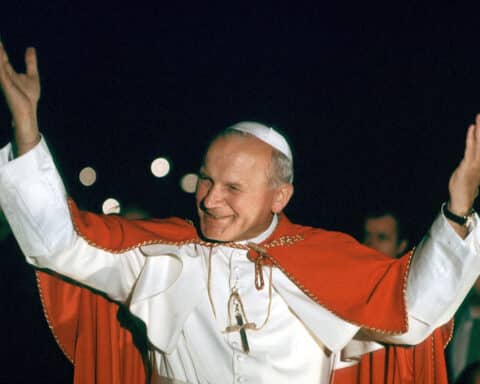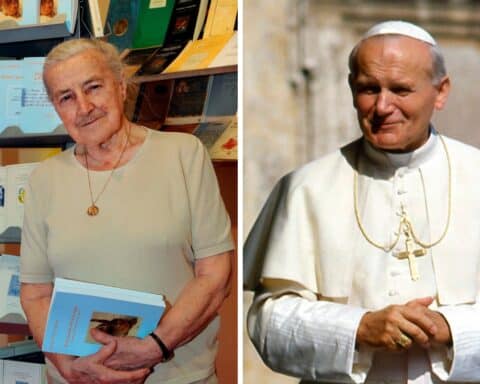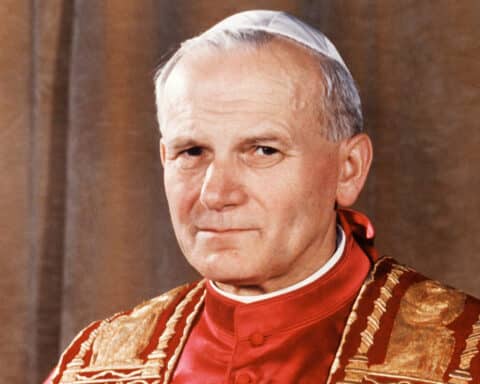Wednesday, May 13, 1981. A warm, sunny late afternoon in Rome. A crowd of 20,000 gathers in the huge square, eager to glimpse and greet the man who smiles, waves and blesses as his open vehicle works its way slowly among them.
Suddenly, shots ring out. Pope John Paul II, his white cassock bloodied, falls back into the arms of his priest-secretary. People scream and run about. Word flashes around the globe: “Pope John Paul was shot today in St. Peter’s Square by an unknown assailant. The pope is en route to the hospital. His condition is not known.”
After 40 years, the attempt to kill Pope St. John Paul II remains perhaps the single most dramatic event of his dramatic pontificate — indeed, one of the most dramatic events in the whole history of the papacy.
But there was more to it than that single event, frozen forever in terrifying images of the stricken pope. For this is a story that, beginning in horror, ends in an act of almost incomprehensible forgiveness.
Shots fired
It started at 5 p.m. on that fateful day as the white Jeep popemobile carrying John Paul emerged from the Vatican enclosure and drove slowly around the square, by 5:13 reaching a point near the basilica’s main entrance and the bronze door leading to the apostolic palace. The pope had just hugged and blessed a little girl and returned her to her parents when the gunman, situated behind the first row of bystanders, raised his 9 mm Browning semiautomatic pistol and fired.
The assassination attempt was carried out by a 23-year-old Turkish gunman named Mehmet Ali Agca, almost certainly acting at the instigation of others, though exactly who and for what reason remain uncertain. According to Agca, there was a second gunman, who fled after the shooting. He, too, tried to escape, but was prevented from leaving — by a nun, it is said — until Vatican security officers seized him.
Accounts differ on whether two or four shots were fired. Two bullets hit John Paul — one in the abdomen, the other grazing his elbow — while two American women in the crowd also were wounded, though not seriously.
Before entering his body, the first bullet struck his hand — a providential accident that diverted it a fraction of an inch from his abdominal artery and spinal column. The bullet then exited his body and fell to the vehicle’s floor.
By far the worst injury to the pope was the abdominal wound. Bleeding profusely but still conscious and praying, John Paul was taken by ambulance to Rome’s Gemelli Hospital, a trip usually requiring 25 minutes that the driver made in eight.
Upon arrival, the papal secretary, Msgr. Stanislaus Dziwisz, administered the last rites, and the pope, who by now had lost a great deal of blood and was unconscious, was admitted immediately to surgery. At 12:45 a.m., the hospital issued a bulletin saying the five-hour surgery was successful.
On June 3, the convalescing John Paul left the hospital and returned to the Vatican. But instead of improving, his condition deteriorated, with his temperature reaching nearly 104 degrees, and on June 20, he returned to the hospital.
There it was determined that he was suffering from a viral infection caused by the emergency use of tainted fresh blood in the transfusion on May 13. After a lengthy recuperation, he returned to the Vatican for a second time on Aug. 14 and gradually resumed his normal schedule.
An unknown motive
One of the unresolved puzzles surrounding this episode is who recruited Agca to kill the pope. The gunman’s background sheds only limited light on that.
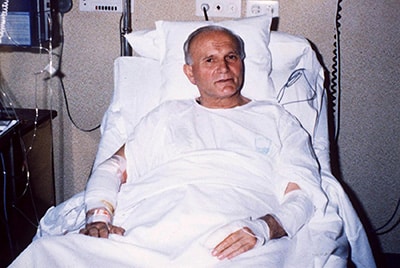
He was born Jan. 9, 1958, in Hekimhan, a town in mountainous east-central Turkey. Growing up, he took to petty crime, turned to smuggling between Turkey and Bulgaria, and became involved in a murky underworld of terrorists, spies and mafiosi.
He also joined the Grey Wolves, a right-wing terrorist group, and in February 1979, he shot and killed a left-leaning Turkish newspaper editor. Sentenced to life in prison, he served six months, then escaped and fled to Bulgaria.
For his attempt on the life of the pope, he was sentenced by an Italian court to life in prison. But in June 2000, he was released at John Paul’s request and deported to Turkey. There he was imprisoned again for the 1979 killing. He was pardoned in 2010.
Agca told different stories at different times about who put him up to shooting the pope, and there is no special reason to believe any of them. Probably the most commonly held explanation for what happened is along the following lines.
Elected in October 1978, the Polish pope’s first foreign visit in June 1979 was to his homeland, and there his charismatic presence touched off a huge upsurge of Polish religious and national enthusiasm. Soon, too, he was giving powerful support to the independent Solidarity labor movement in its struggle with the communist regime.
Observing these developments, the men in the Kremlin concluded that John Paul was a threat to their hold on Poland and the rest of Eastern Europe. Soviet intelligence thereupon concocted a scheme to kill the Pope, using East German and Bulgarian intelligence as agents. The Bulgarians then recruited Agca to do the job.
All this may or may not be true.
An act of forgiveness
But we do know that on Dec. 27, 1983, something extraordinary happened in Rome’s Rebibbia prison. Pope John Paul visited Agca and spent 20 minutes speaking with him privately.
“What we talked about will have to remain a secret between him and me,” the pope said. “I spoke to him as a brother whom I have pardoned and who has my complete trust.”
Just 33 years after he attempted to assassinate the pope, on Dec. 27, 2014, Mehmet Alia Agca, a free man by now and reportedly a convert to Catholicism, visited the pope’s tomb in St. Peter’s and left a bouquet of white roses.
There is one other twist to this story. John Paul was shot at the exact time of day on the exact day of the year that the Blessed Virgin first appeared to three peasant children at Fátima in Portugal in 1917. The pope credited his survival to Mary.
He also reported that the third of three messages or “secrets” entrusted by the Virgin to the children concerned the attempt on his life. On May 13, 1982, one year after he was shot, John Paul II went to Fátima and gave the shrine the bullet that nearly killed him. It is there now, encased in the crown atop Mary’s statue.
Russell Shaw is a contributing editor for Our Sunday Visitor.

